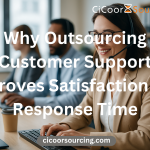In today’s competitive digital space, social media is a critical part of any business’s marketing strategy. However, managing your company’s social presence across multiple platforms can be time-consuming and resource-heavy. Outsourcing this task to a virtual assistant (VA) can relieve that burden while ensuring your social media is handled professionally and efficiently.
Here’s how to successfully outsource your social media management to a virtual assistant, ensuring you optimize your strategy while maintaining a strong online presence.
1. Establish Clear Social Media Objectives
Before you delegate social media responsibilities to a virtual assistant, it’s crucial to outline your key objectives. Are you aiming to boost brand awareness, drive traffic to your website, or enhance engagement with your followers? Having clear goals helps guide your VA’s efforts and ensures your strategy is aligned with broader business targets.
Steps to Define Objectives:
- Set specific, measurable goals (e.g., increasing followers, improving engagement rates, driving sales).
- Determine which platforms (Instagram, LinkedIn, Twitter) best reach your target audience.
- Provide clear guidelines regarding the tone, style, and type of content to be posted.
These well-defined objectives will set your virtual assistant up for success and ensure their efforts contribute to your overall marketing strategy.
2. Choose a Virtual Assistant with Social Media Expertise
Not all virtual assistants specialize in social media, so selecting a VA with the right skill set is essential. You’ll want someone with a strong understanding of social media platforms, content creation, and audience engagement.
Considerations When Hiring:
- Experience: Look for VAs with proven experience managing social accounts, and ask to see examples of their work.
- Familiarity with Tools: Your VA should be adept at using social media tools like Hootsuite, Buffer, or Later, as well as design platforms like Canva.
- Strong Communication Skills: Since your VA will likely be handling customer interactions, they should be capable of managing inquiries professionally and efficiently.
Choosing a VA with relevant expertise ensures that your social media presence remains active, consistent, and professional.
3. Provide Thorough Onboarding and Guidelines
After hiring the right VA, it’s important to give them the tools and knowledge they need to represent your brand accurately. Even with a seasoned VA, providing detailed onboarding materials ensures that your brand’s voice and values are well-represented.
Onboarding Best Practices:
- Share your brand guidelines, including tone of voice, key messages, and visual elements.
- Provide access to assets such as logos, images, and brand-specific templates.
- Offer examples of high-performing content to guide future posts.
Thorough onboarding ensures your VA can create and manage content that aligns with your business identity.
4. Implement Social Media Scheduling Tools
Efficiency is key when managing social media across various platforms. Social media scheduling tools like Buffer, Later, and Hootsuite can help streamline the process. By planning and scheduling content in advance, your VA can maintain a consistent posting schedule without sacrificing quality.
Advantages of Using Scheduling Tools:
- Consistency: Posts are published at optimal times, ensuring your content reaches a broader audience.
- Time Management: Your VA can plan posts ahead of time, allowing for more strategic content planning.
- Review Before Posting: Scheduling tools allow you to review posts before they go live, giving you final approval.
Using scheduling tools helps your VA manage social media more effectively while ensuring high-quality content is regularly posted.
5. Foster Engagement and Real-Time Interactions
Automation tools can help manage content posting, but they can’t replicate real-time engagement. Having a virtual assistant available to interact with your audience ensures timely responses to comments, messages, and inquiries, which is crucial for maintaining customer relationships.
Key Engagement Tactics:
- Timely Responses: Ensure your VA is responding quickly and professionally to follower interactions.
- Monitor Mentions: Have your VA track brand mentions and engage with users discussing your products or services.
- Encourage User-Generated Content: User engagement can be further encouraged by resharing customer content or running contests.
An active presence in real-time interactions helps build a stronger relationship with your audience and enhances your brand’s reputation.
6. Monitor Social Media Performance Regularly
To ensure your outsourced social media efforts are paying off, it’s important to track performance metrics. By regularly reviewing key performance indicators (KPIs) such as engagement rates and follower growth, you and your VA can fine-tune your strategy for continuous improvement.
Metrics to Monitor:
- Engagement Rates: Measure how well your audience is interacting with your content (likes, comments, shares).
- Follower Growth: Track how quickly your social following is increasing across platforms.
- Conversions: Monitor how many social interactions are leading to website visits, sign-ups, or purchases.
Reviewing these metrics allows you to optimize your social media strategy, ensuring that your VA’s efforts lead to tangible business outcomes.
Conclusion: Maximize Your Social Media Strategy with a Virtual Assistant
Outsourcing social media management to a virtual assistant can free up valuable time while ensuring your brand remains active and engaging across social platforms. By setting clear goals, selecting a VA with the right experience, and providing structured training, you can seamlessly integrate a VA into your marketing efforts.
Ready to elevate your social media presence? Contact us today to connect with a virtual assistant who can expertly manage your social media strategy.






